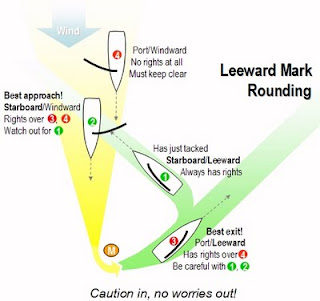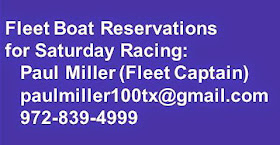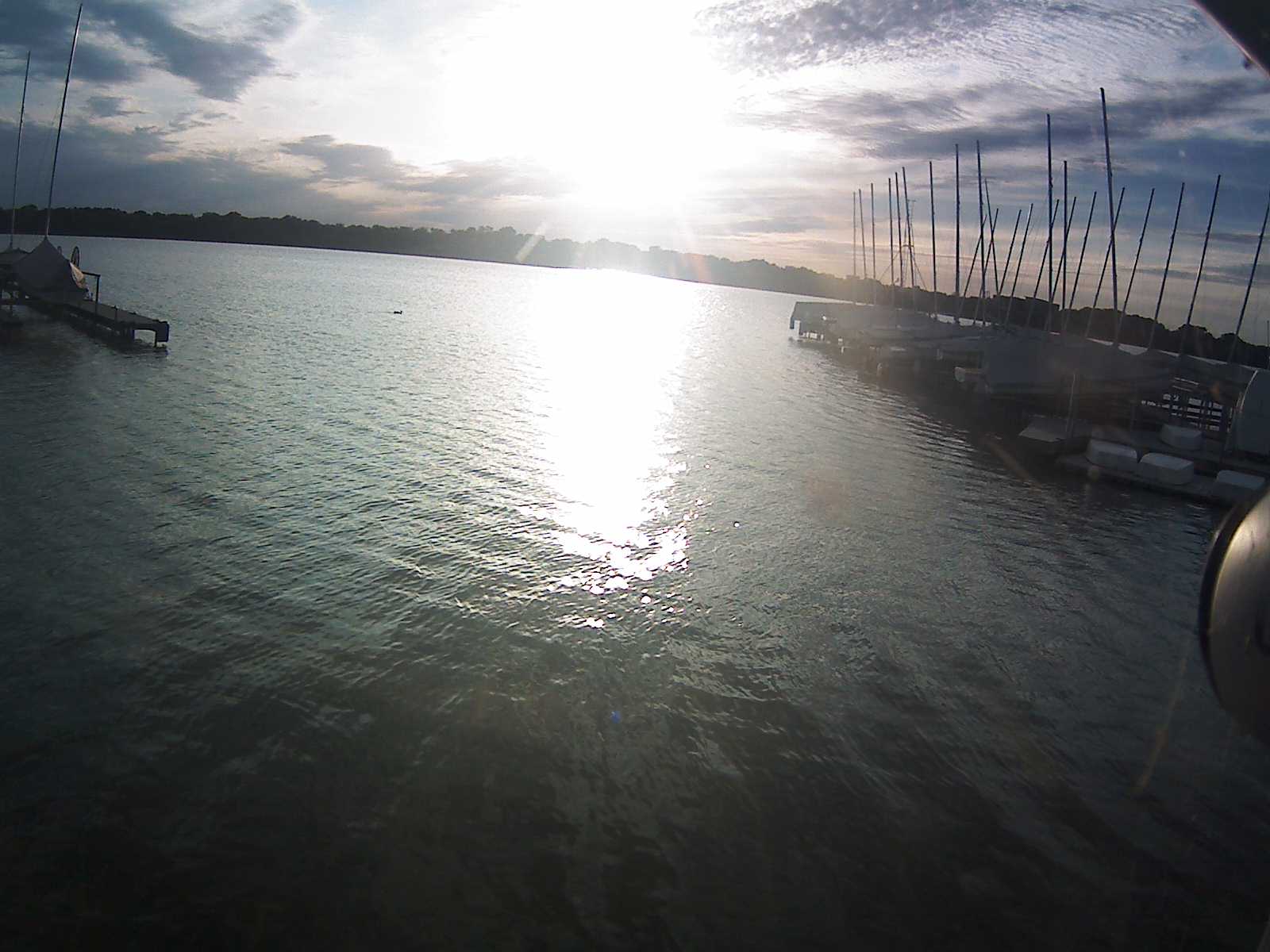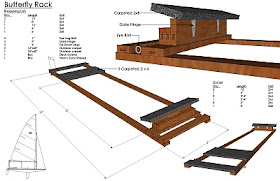BEGINNING SAILING (a female perspective)
 What to expect - When first starting to sail, you will likely start out a little overwhelmed and intimidated, then perhaps progress to being confused and sometimes embarrassed, then finally start to feel more comfortable but the intimidation probably won’t go away until you build confidence by tipping a few times and then jumping in and making a complete fool (or ass) of yourself as you learn the rules. Have no fear, the Butterfly fleet is the perfect place for you. There will always be someone there to come to your rescue or to pretend they didn’t see you do something really silly and forgive you and gently correct you when you barge right in and hit everything in sight. At some point or another, we’ve all done it too and you will be a welcome reminder of our own progress. When you find that you are out of control, the default is to scream and let go of everything and hang onto the boat. It’s a pretty effective recovery technique (unless you're driving the committee boat).
What to expect - When first starting to sail, you will likely start out a little overwhelmed and intimidated, then perhaps progress to being confused and sometimes embarrassed, then finally start to feel more comfortable but the intimidation probably won’t go away until you build confidence by tipping a few times and then jumping in and making a complete fool (or ass) of yourself as you learn the rules. Have no fear, the Butterfly fleet is the perfect place for you. There will always be someone there to come to your rescue or to pretend they didn’t see you do something really silly and forgive you and gently correct you when you barge right in and hit everything in sight. At some point or another, we’ve all done it too and you will be a welcome reminder of our own progress. When you find that you are out of control, the default is to scream and let go of everything and hang onto the boat. It’s a pretty effective recovery technique (unless you're driving the committee boat).Personally, I’ve dropped the tiller and spun in circles more times than I can remember and I’ve made more mistakes in the rules than I can forget and I’ve been everything from elated to scared to frustrated and mad. All good stuff. Some best in hindsight though. The point being, if you sail with the Butterflys, you’re going to be part of a family so just jump in and get comfortable and do your worst (and best).
What to bring - In the summer - water, life jacket, whistle, gloves, water, sunscreen, sunglasses, hat, water, and a bite to eat at lunch and some more water. In the winter - life jacket, whistle, gloves, sunscreen, sunglasses, hat, water, a bite to eat, a light wind and waterproof layer as well as a comfortable warmth layer and a change of clothes.
Where to go - The Butterflys usually sail an Olympic (O) course, but you might see a Windward/Leeward (W) or a Triangle (T). Here are the basic diagrams of the courses. Many of your fellow sailors are over 40 and we often forget what someone just said or what we just saw on the course board and we have to ask for reminders all the time. So feel free to ask anyone out there anywhere along the course where you are supposed to go next. If you don’t get an answer don’t assume they are ignoring you. In all likelihood, they are very friendly and willing to help you but they just can’t hear you. You might have to use your whistle to get their attention.
 What’s the goal - At some point you’ll ask yourself this question and it will often change. I’ve found that many women enjoy being on the water and they enjoying doing well in the fleet and feeling competitive but they don’t necessarily enjoy the competition when it comes to having to learn the rules, assert their rights and fight for their position. So do what’s comfortable. Put yourself in or out of the competition as you see fit. There is no reason you can’t start 30 seconds or a minute early and avoid the stress of the starts to begin with. The fleet will catch up to you and then you’ll have people around you that you can watch and copy. There is no reason you have to round every mark on the course. If you’re just beginning, it’s hard to learn when you’re at the back of the fleet all by yourself. So just go out and sail with the other boats even if that means starting early and skipping a few marks and turning and joining the fleet. Only start and round marks when you feel ready. Just be sure to tell the committee boat if you didn’t sail the entire course so they’ll know whether to score you.
What’s the goal - At some point you’ll ask yourself this question and it will often change. I’ve found that many women enjoy being on the water and they enjoying doing well in the fleet and feeling competitive but they don’t necessarily enjoy the competition when it comes to having to learn the rules, assert their rights and fight for their position. So do what’s comfortable. Put yourself in or out of the competition as you see fit. There is no reason you can’t start 30 seconds or a minute early and avoid the stress of the starts to begin with. The fleet will catch up to you and then you’ll have people around you that you can watch and copy. There is no reason you have to round every mark on the course. If you’re just beginning, it’s hard to learn when you’re at the back of the fleet all by yourself. So just go out and sail with the other boats even if that means starting early and skipping a few marks and turning and joining the fleet. Only start and round marks when you feel ready. Just be sure to tell the committee boat if you didn’t sail the entire course so they’ll know whether to score you.
Signals - There are many signals but to begin with just learn two flags and 4 times - Class flag, P flag and 5-4-1-go. The class flag is a white triangle with a red circle. The P flag is a blue flag with a white square. At five minutes before the go, there will be a sound and the White/Red flag will go up; at four minutes before the go, there will be a sound and the Blue/White flag will go up; at 1 minute before the go, there will be a long sound and the Blue/White flag will go down; then at the go, there will be a sound and the Red/White flag will go down.
Port/Starboard - Somehow this simple concept can be very difficult to remember when sailing. Visual reminders in the form of port/starboard cards taped to the deck wouldn’t be a bad idea.

Let’s go into detail with ways to remember it. Port tack is the easiest to remember and starboard is everything opposite. Port tack is when the wind is coming across the port/left side of the boat (looking forward) and the sail is on the right side of the boat. Port is a four letter word, left is a four letter word, port is a red wine and the color red is associated with port tack.
At night all boats and planes have red and green navigation lights. Red is on the left and green is on the right. Port, left, red. Port tack has to yield right of way to starboard so port/red is kind of like a stop light and starboard/green is like a go light. Learning port/starboard is fairly easy but when you meet another boat coming the opposite direction somehow the mirror image often causes confusion. When taking flying lessons, I learned a saying that they teach because at night if you see another plane all you might be able to see is their red and green lights and because you are traveling at high speeds it is important to quickly determine if you are on a collision course. Right-red-wrong. If a plane is coming at you and the red light is on the right, you are on a collision course. I use this saying when sailing except it’s right-sail-wrong. If a boat is coming at me and their sail is on my right (looking directly at them), then they are on starboard.
Rules - This is the most intimidating part. How are you supposed to keep them all straight when you’re having trouble even remembering what tack you’re on much less keeping track of someone else. To begin with, keep the rules super simple.
1) Starboard;
2) Leeward;
3) Clear Ahead;
These are the boats with right of way and you apply the rules in this order and go with the first one where there is a difference in the boats. You are not required to announce your presence or rights but may do so as a courtesy.
Starboard - If you are on starboard and another boat is on port, you have rights and you may alert them to your presence by calling out ‘starboard’.
Leeward - If you are both on starboard or both on port, move to the next rule, and if you are the leeward boat, you have rights. The wind direction is always determined by where the sail is. The side of the boat the sail is on is leeward. So the boat furthest from the wind (the side the sails are on) is leeward and that boat has rights. So if you are the leeward boat, the other person’s sail will be closer to you than the person and they might not be able to see you and you may alert them to your presence by calling ‘leeward boat’.
Clear Ahead - If both boats are on the same tack and neither is windward or leeward of each other but one is behind and the other ahead, you move to the next rule and if you are ahead you have rights.
Anytime your circumstances change (someone tacks, gybes, overtakes), go back to rule one and go with the first rule where there is a difference. It’s that simple, 1-2-3. So, if two boats are on port tack and one is ahead of the other, you’re on rule three but if the boat behind tacks to starboard, you go back to rule one and the starboard boat has rights.
For almost anything else someone will talk to you and ask for room or whatever else. Just keep in mind that at mark roundings, the inside boat is entitled to room if they ask.
Now, how to keep it straight. First, what tack are you on? Next, what tack is the other boat on? When they are going the same direction as you, it’s easy. When they are coming directly at you, remember one thing, if their sail is on the right side (as you are looking at them), they are starboard. Right-red-wrong - right-sail-wrong. It’s my personal danger, danger, danger signal.
Let’s look at a few common scenarios for approaching and leaving marks because you can simplify things or complicate them depending on where you sail. Think logically about where you will most likely find yourself when you first start racing ... behind. Therefore, more often than not, you will be meeting boats at mark roundings that are going the opposite direction from you. So let’s look at the course in terms of where you want to place yourself versus where you don’t want to place yourself. The reason for this is because as you meet boats and figure out whether you have rights, they can change from port to starboard in a matter of seconds and completely confuse you so if you’re sailing in a complicated area on the course where they can turn the tables on you quickly, the rule of thumb will be don’t sail there or plan to have to yield right of way if you do.
Here is a basic diagram of what you might find as you approach the windward mark. As you can see it’s best to approach on starboard and leave on starboard.

Here is a basic diagram of what you might find as you approach the leeward mark. As you can see, you will need to yield to boats as you approach the mark and not worry about it as you leave.

How to Start - It is common to feel intimidated and hang back and not be on the start line. That’s ok but will put you well behind the fleet which isn’t much fun. Don’t feel like you’ll be in the way if you get closer to the line and mix with the other boats. You will, in fact, be in the way but just consider yourself a speed bump. The better sailors (read competitive) will see you and be proud of you for making the effort and can easily maneuver around you. There are alot of ways to determine the favored end of the line, the favored side of the course, etc. There are many different starting techniques. Many beginners tend to hang back and try to make a timed run at the line so they can steer a straight course and avoid right of way issues. That works fine. Another good approach is to do a couple of practice starts to get comfortable. Just do circles around the committee boat a few times. Watch out for the anchor line in front. As you hit the line in your circle, bring your sail in all the way and point as high as you can without stalling and then just look at the RC boat and the pin end of the line and pretend the gun just went off. Are you ahead of the pin end or behind it? If you’re ahead then the boat end is favored and if you’re behind then the pin end is favored. This means the fleet will generally bunch up on the favored end of the line. You might choose to start with them or away from them but this will give you a clue as to where they will end up with their last minute maneuverings.
Upwind - The two biggest factors on this part of the course is dirty air and when to tack. Beginners tend to follow and following often means sailing in dirty air. If you notice it, great, don’t do it. If you don’t, keep track of who you’re following and ask them later if you were sailing in their dirty air and if so, have them show you what they’d recommend. As for when to tack, there are lots of things to keep track of but even the better sailors are always learning better ways. Let’s just keep it simple. Sail the tack that takes you closest to the mark. You’ll have to imagine what the other tack will look like and then chose which is closer. Next, if there are boats around you, look at the angle of your boat compared to theirs. If they are sailing higher (bow pointing closer to the mark), then you are losing ground and need to tack. As you get closer to the mark, try to avoid sailing in complicated areas until you get more comfortable with the rules.
Reaching - Reaching is usually the best part of the course. It somehow feels like what sailing is supposed to feel like. Just enjoy the ride. If you find yourself gaining on someone (women usually do best here) just remember you usually have no rights when coming from behind and that the passing lane (on an Olympic course) is usually to the right (going high).
Downwind - This is the part of the course where you let the sail all the way out, lift the board a little and work on balance and looking behind you to see where the wind is building and seeing where your tell tales say the wind is. Just keep it simple and stay in control. If the boat feels unstable, put your board down and pull your sail in a little.
This should get you around the course with very little discomfort from the racing aspect and will allow you the luxury of getting comfortable with your boat handling. You’ll know when you’re ready to move to the next level and there will be lots of advice from your fellow Butterflyers once you get these basics down.










9/06/2011 8:54 PM
Love this. Just what I need. Now if I could just get it all in my brain at one time. I printed it out and plan to review before the next time I race.